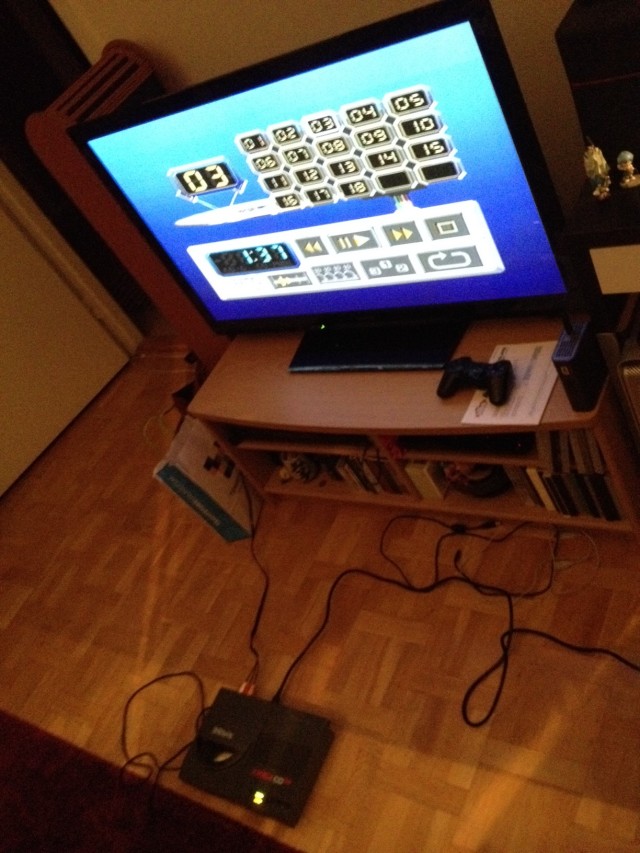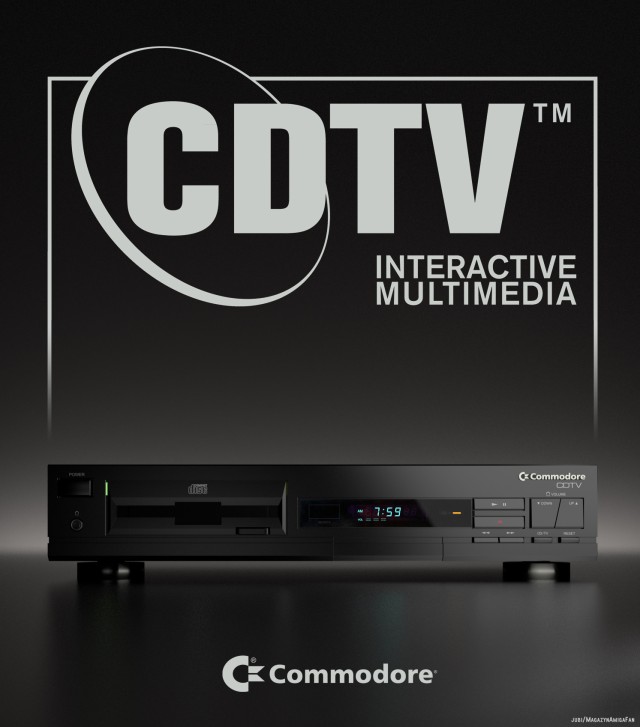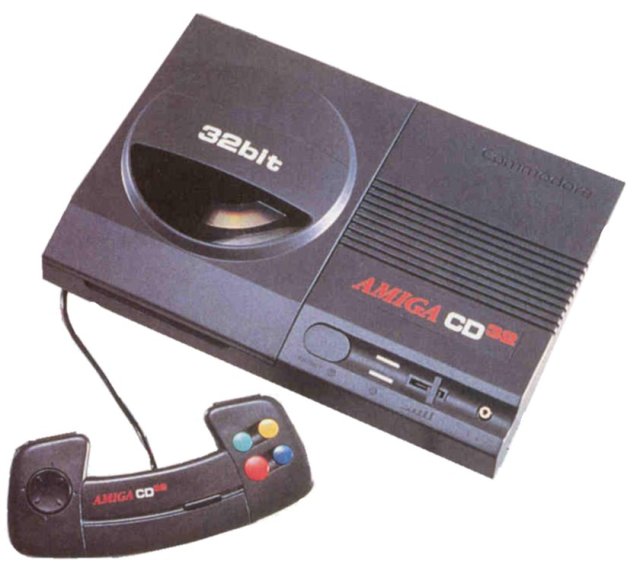OT: Got myself a CD32!
 This may be a surprise for some of you, but I have not owned a classic Amiga since the early 2000. For me, Amiga has never been about the past but about the future. So during the years between 1997 to 1999 I expanded my A1200 as much as I could afford before giving up on that (partly due to the price, partly because of lack of progress in the Amiga world). Then I sold it, bought myself a faulty A3000 which I sold around 2000 or 2001. Then I was without an Amiga until 2012, when my interest rekindled after reading about NG Amigas. First AmigaOS 4, then AROS and lastly MorphOS.
This may be a surprise for some of you, but I have not owned a classic Amiga since the early 2000. For me, Amiga has never been about the past but about the future. So during the years between 1997 to 1999 I expanded my A1200 as much as I could afford before giving up on that (partly due to the price, partly because of lack of progress in the Amiga world). Then I sold it, bought myself a faulty A3000 which I sold around 2000 or 2001. Then I was without an Amiga until 2012, when my interest rekindled after reading about NG Amigas. First AmigaOS 4, then AROS and lastly MorphOS.
But I have been longing for an classic for a while still. But I had to ask myself exactly what I was longing for. It wasn’t the OS anymore since MorphOS does a fine job at being AmigaOS (only better). It wasn’t the hardware either. No, for me it’s simply the games and the scene demos. With that in mind, I came to the conclusion that a Amiga CD32 would be the best buy.
After looking around for a good while I did find a very nice deal: A CD32 with the SX1 expansion (meaning it will turn the console into a Amiga 1200), 15 games and all the stuff needed to just plug it in and play. Today it arrived and it worked flawlessly. I haven’t tested it beyond playing some games but I’m rather happy so far. The only issue is the hand controller. It’s an original CD32 one and they have always been kinda sucky. And 20 years of use doesn’t help either. So I ordered myself two Kipper PSX controller adapters (homepage). I’ve always liked the feel and quality of Sony Playstation controllers so this will make the game experience at least 100% better.
Commodore and the CD32
 Early 1991 Commodore started to sell the Commodore Dynamic Total Vision (CDTV); an Amiga 500 with a CD reader and a CD player look to match it. This was going to be Commodores triumphant entry into peoples living room, but it bombed horribly.
Early 1991 Commodore started to sell the Commodore Dynamic Total Vision (CDTV); an Amiga 500 with a CD reader and a CD player look to match it. This was going to be Commodores triumphant entry into peoples living room, but it bombed horribly.
First, it was a very confusing product. Not really a computer, not really a CD player and not really … anything really. A hard sell indeed. Second, it was really expensive (599 USD or about 1000 USD in 2014). Third, it was underpowered by 1991’s standard. Not enough CPU power, not enough memory and too slow a CD reader for smooth animation playback. It also lacked the promised CD-Video showing abilities. Forth, Amiga owners had very little incentive to buy this machine instead of an Amiga 500, besides the CD reader. This included, fifth, the lack of possibility if piracy. Most Amiga owners where teenagers without money. They simply could not afford to buy every ‒ or even a few ‒ of the games and programs on the market. Being able to copy from each other made the computer very popular.
This costly failure would become one of the main reason for Commodores bankruptcy in 1994. But they didn’t give up yet. First they made a CD add-on for the Amiga 500 (something they hadn’t planned but after the flop of the CDTV became obvious Commodore changed their mind) called the A570. However, it didn’t start to sell until after they stopped manufacturing the Amiga 500. It didn’t stop it from selling quite well though. After that they tried to make a cost reduced CDTV but that eventually didn’t go anywhere. Based on the Amiga 600, the so called “cost reduced Amiga 500″ that was even more expensive than the Amiga 500, it was simply not cheap enough. Being too weak to play CD-Video they made an add-on for a FMV module that could play these videos.
But the lack of success made Commodore lose faith in the Amiga computer. They wanted out and get into the more lucrative PC business. Late 1991 they closed down the Amiga development department, tried to sell out their remaining stock and focused entirely on the PC market. But within six months they realised that this was an even worse opportunity. Commodore simply didn’t have the resources to produce or sell enough PC machines to break a profit in the fierce market. They quickly reopened the Amiga department again and first tried to raise interest for yet another underpowered, outdated Amiga. Commodore subsidiaries had the right not to buy anything the American headquarters proposed, and thus no one wanted this machine. That finally convinced Commodore that they needed something new, powerful and fast.
Dave Haynie (famous Commodore Amiga developer) had a prototype for the next generation Amiga graphic chip (the AAA) already in 1990. But that was scrapped before it was finished. Since they now needed something quickly they produced a stop gap chip called the AA, later renamed to the AGA. In September 1992 Commodore released the high end Amiga 4000 and the month after the low end Amiga 1200. The latter sold pretty well, though it could just barely compete with the PC by this time (The Amiga 500 had been way before it’s competitors in price/performance in 1987).
The same month an engineer named Jeff Porter combined the AGA chip with the closed CDTV Cost Reduce project. This included a port for a FMV module and a keyboard port. He also added the Akiko chip that was able to produce simple chunk-to-pixel 3D effects (meant for Doom like games). He designed it to look like a SEGA Mega CD and wrote “32bit” in big letters on the cover. In the early 90’s, having more bits was a big selling argument. Christened the Amiga CD32, it was presented at CES in June 1993. By September it was on sale for about 250 British pounds (about 450£ in 2013) with six games.
Commodore claimed it was the first 32 bit CD based game console. This was true in Europe but in Japan Fujitsu has released the FM Towns Marty earlier that year. It was a massive flop. The first three months the CD32 had sold some 100.000 units, and it sold especially well in England. The CD32 had dominated the non music CD sales that Christmas and had a 50% share of the market. The Amiga companies loved the CD32 since it was easy to port to and was impossible to copy illegally (affordable CD burners was years ahead still). But Commodore, deep in debt, could not manufacture enough CD32 (as well as Amiga 1200’s). According to Dave Haynie Commodore could easily have sold 250.000 units the first three months. If Commodore had eventually reached 400.000 it could have survived. In January 1994 Commodore announced that it would sell the CD32 in the States. This was a bold move since they had a very small market there, had terrible relations with the retail stores and Nintendo and SEGA where kings there.
However, when they started to ship the game console they where stopped by the customs. Earlier, Commodore had lost a patent case and owned 10 million dollars. Lacking money, they refused to pay since they needed to pay other companies for parts just to stay alive. For this reason, the US government had put an import ban on Commodore until they paid. Being unable to do so, the ship had to return to the factory in the Philippines. Commodore realised that their days where numbered. They started to lay off people until almost no one was left, cancel most of their projects and simply tried to delay the inevitable for as long as possible.
They reached their limit in April 1994 and declared voluntarily liquidation on April 29 1994.
The CD32 was Commodore’s last machine. The state owned factory in the Philippines tried to cover it’s losses by illegally selling the NTSC CD32 consoles for several years. About 100 games was eventually released for it. Most of the games where “shuffleware”, that is, the exact same games that was released on floppy discs for the Amiga 1200 except for maybe some added speech, film clips or music. It rarely added anything to the actual game play.
The history has an ironic twist. When Jay Miner developed the prototype for the Amiga in the early 1980’s he was making a game console that could be expanded into a complete computer. Commodore did not want to be associated with “mere gaming computers”, even though that’s what they where famous for and where they made their money (like the Commodore 64). So they tried to turn this game oriented computer into a high end system for professionals. They where not successful. Only reluctantly did they produce the low end versions of that computer but they where never happy with it being associated with games and games only. Not until the very end they realised the Amigas strength as a gaming platform and and poured their hearth and soul into it. But by this time they didn’t have the funds to make it a success. The CD32 was a true gaming console, but just like Jay Miner imagined with his prototype it could be expanded into a complete computer. Several modules was released by third party developers that did just that: like the SX1 and the SX-32. The Amiga ended just like it started, with a big interlude in between where it was anything but a “mere” gaming console.
Jay Miner passed away from kidney failure 20th of June 1994, not two months after Commodores demise.
However, it’s very doubtful that the CD32 could have been a success in the market in the long run, even if Commodore had survived. By the early 1994 the Sony Playstation was announced. It was a very impressive machine and when it was released in December 1994 in Japan it outclassed everything, ending the domination of Nintendo and eventually forced SEGA to leave the market. It also killed the Atari Jaguar in 1996, the last American based game console until Microsoft started to sell their XBox in 2001. Not unless Commodore could finish and produce a cheap Hombre based gaming console by the early 1995 could they have stayed afloat. A herculean task to say the least.
The CD32 had a good run, and could well have existed for one more year. Too bad it didn’t. But it still have some really good games and some equally good memories in store for me at least.
